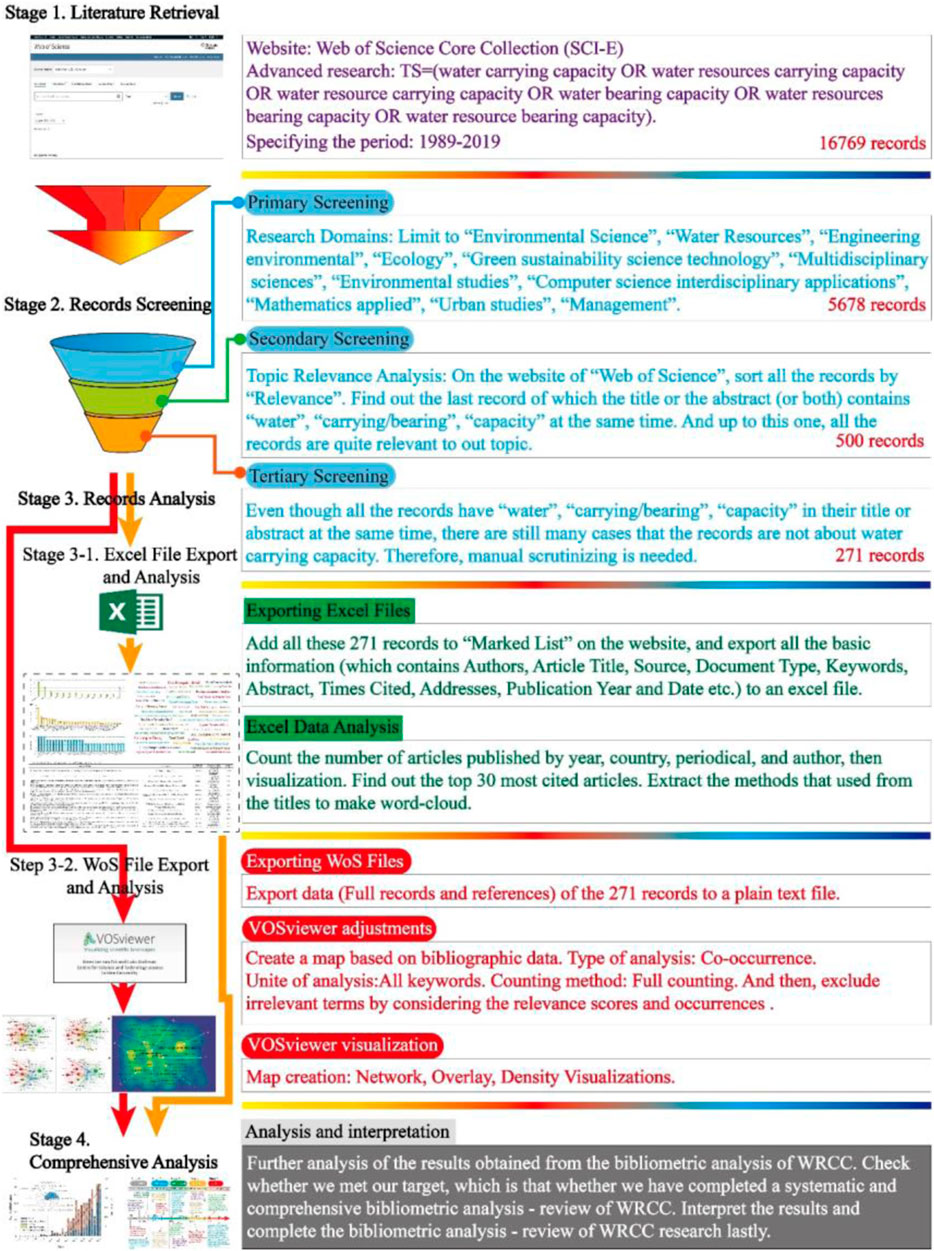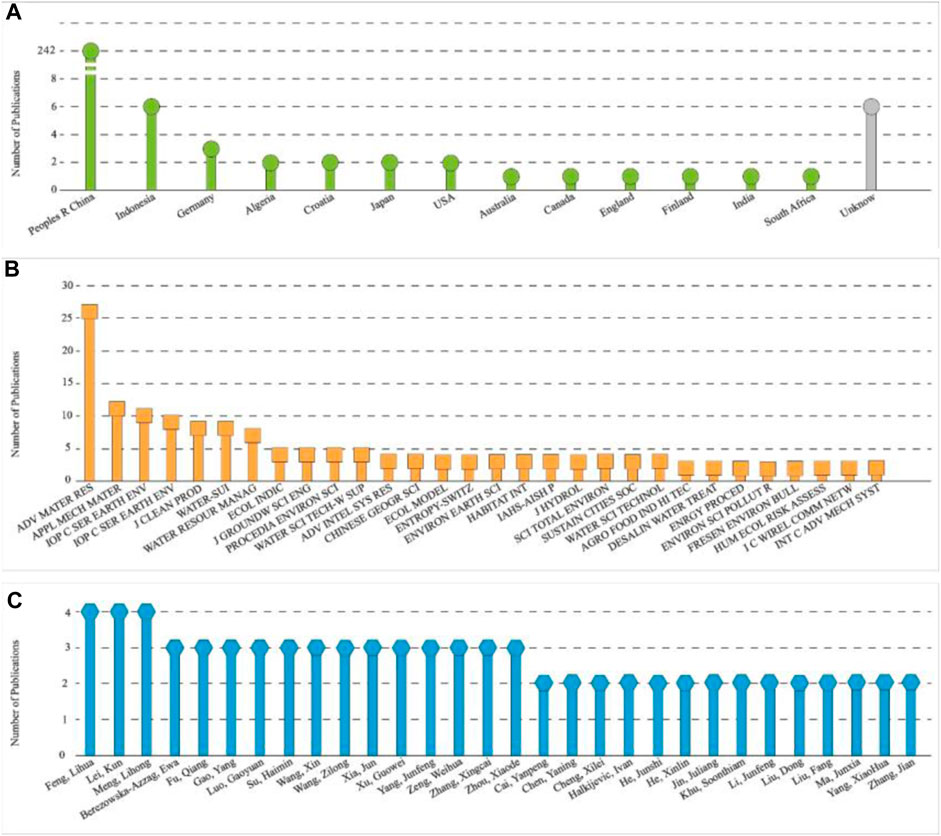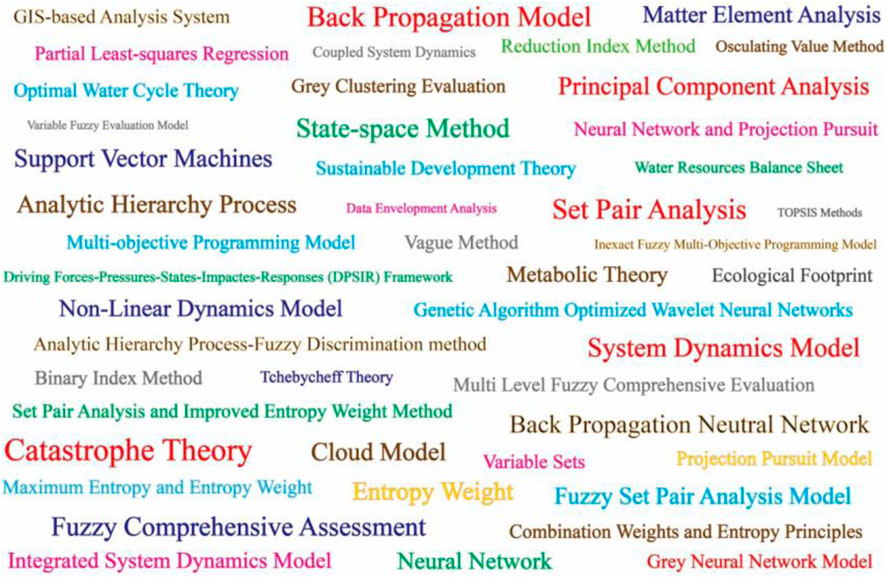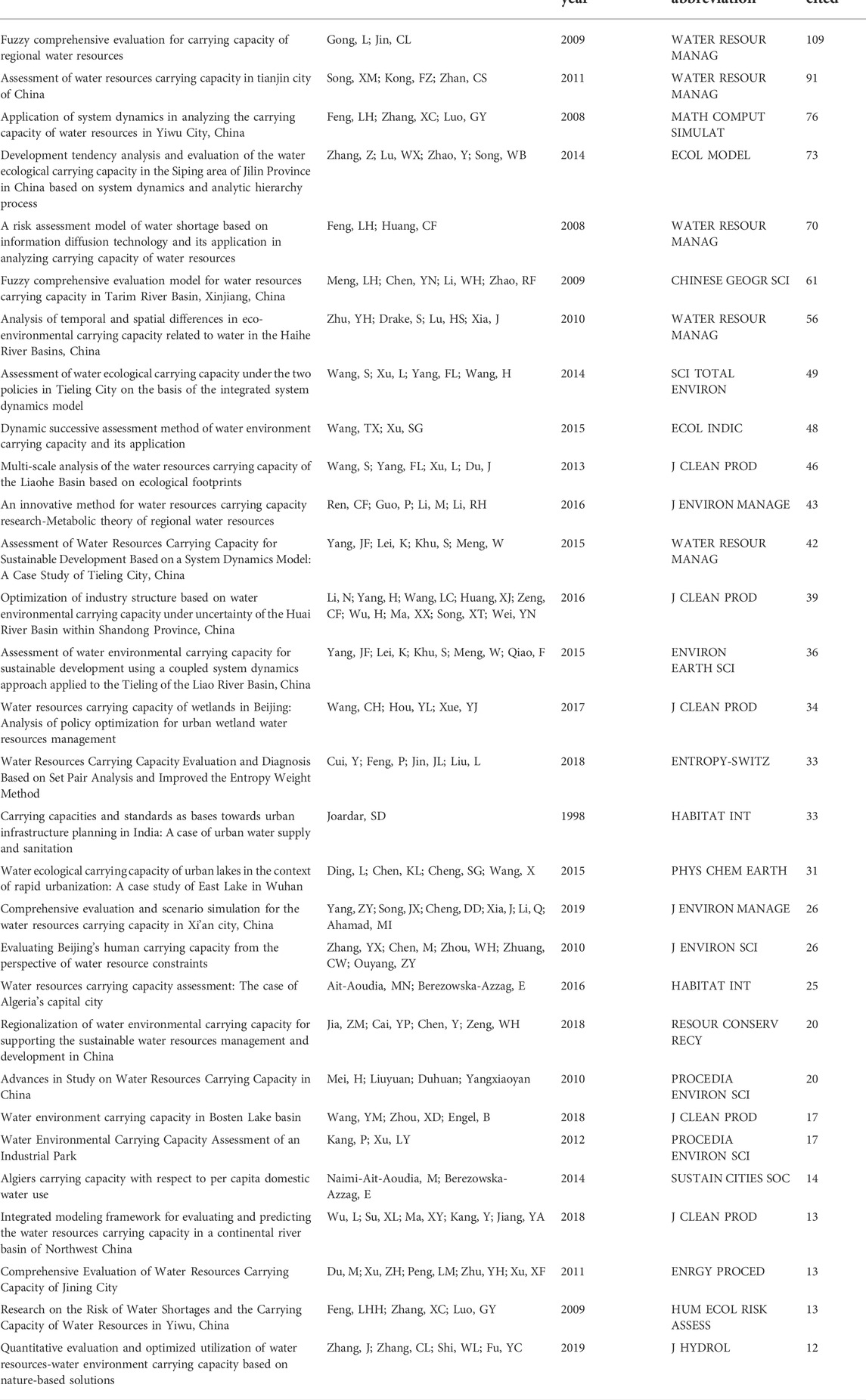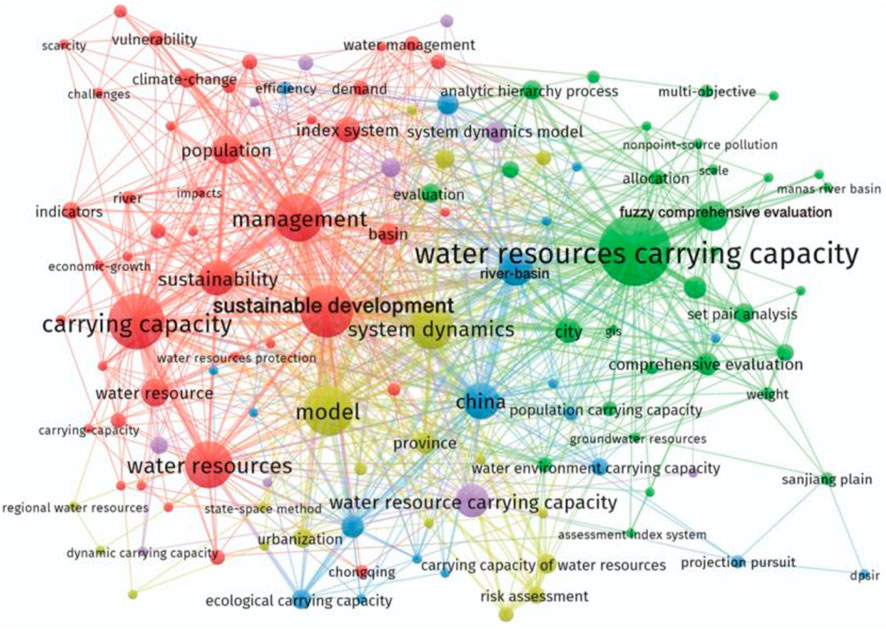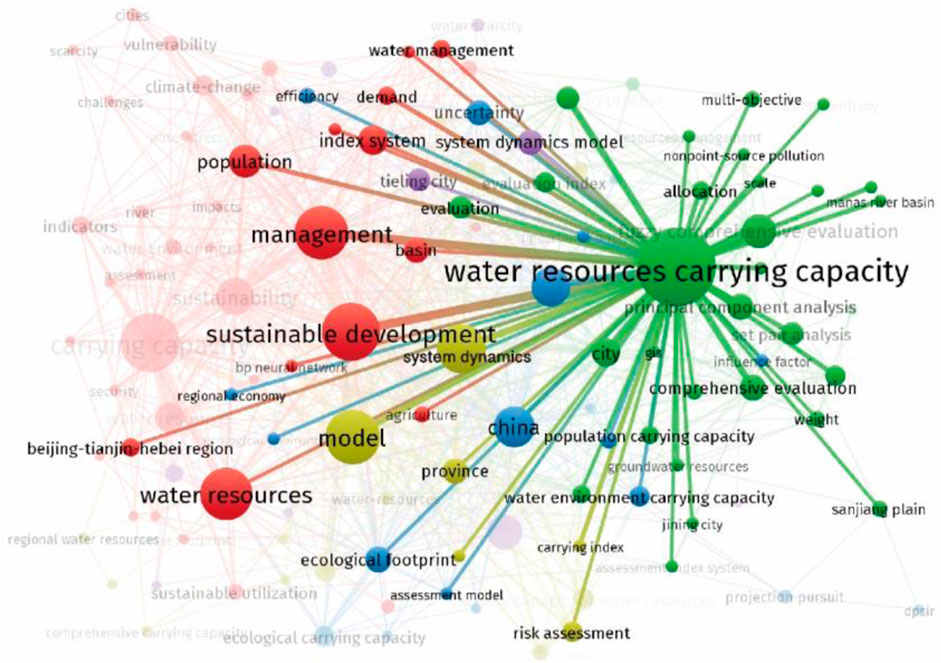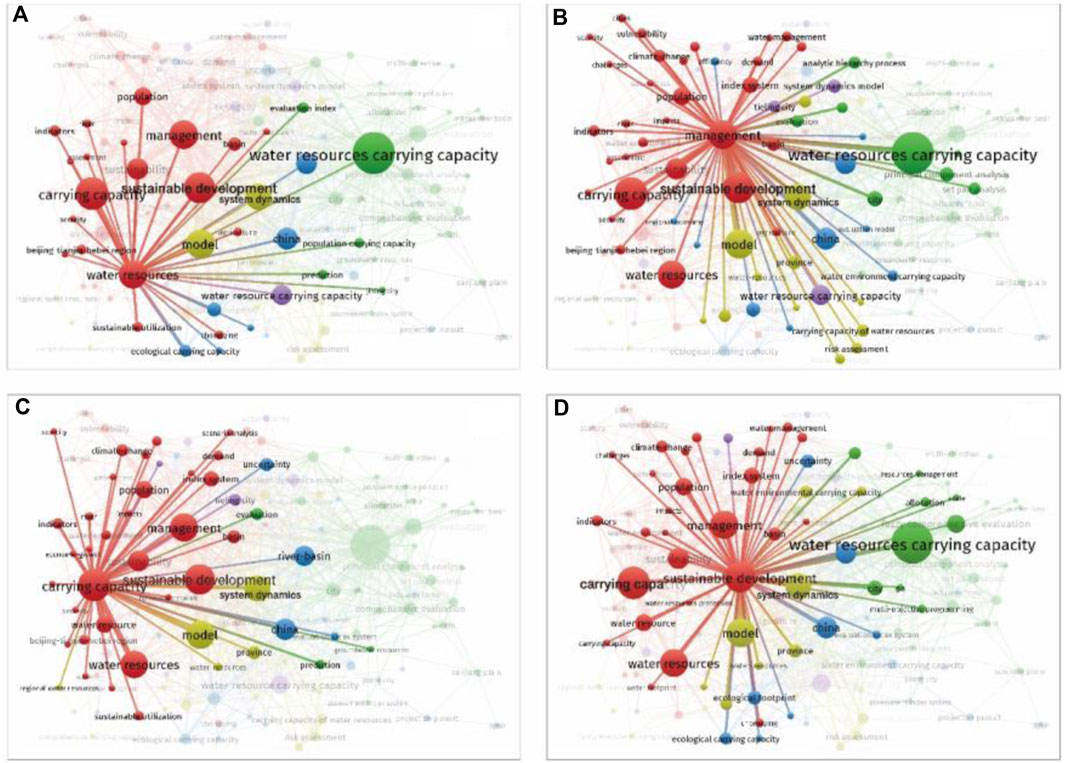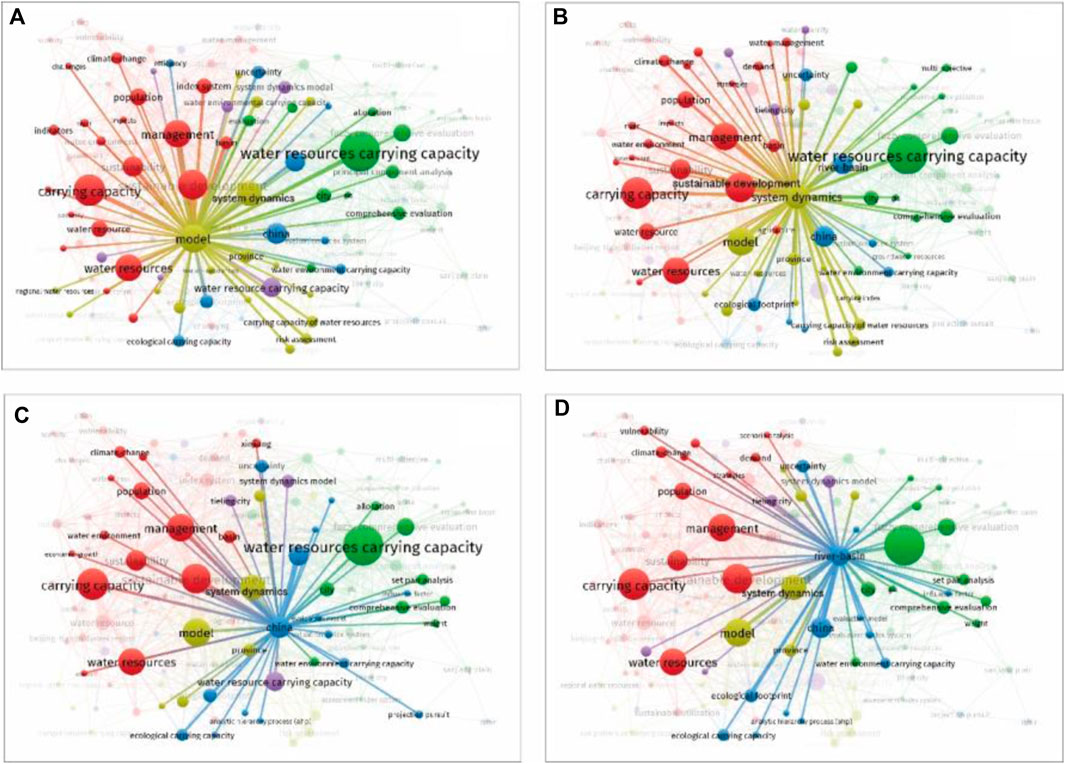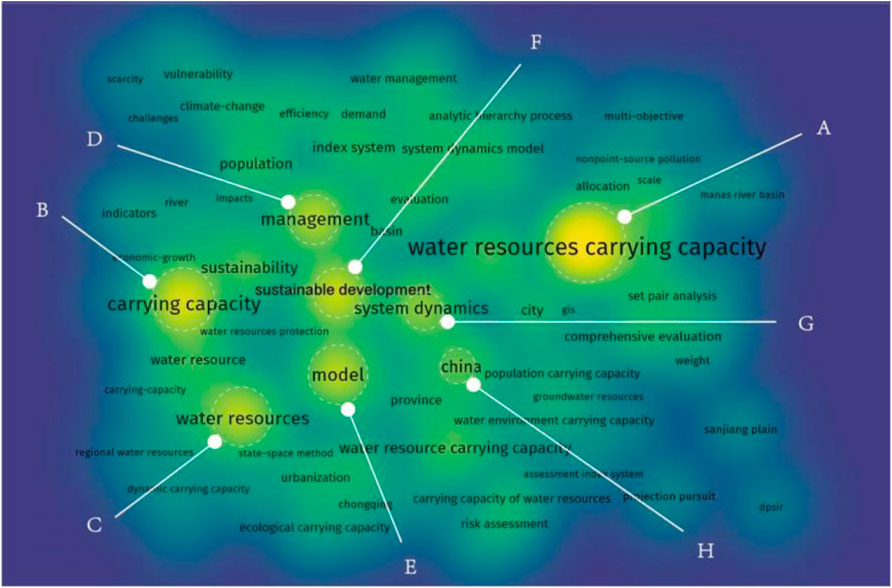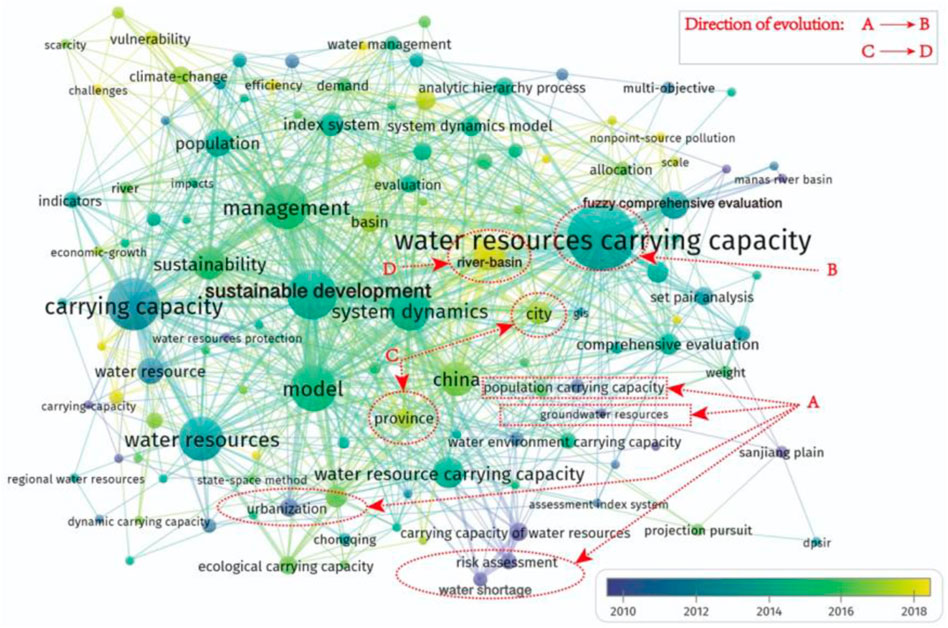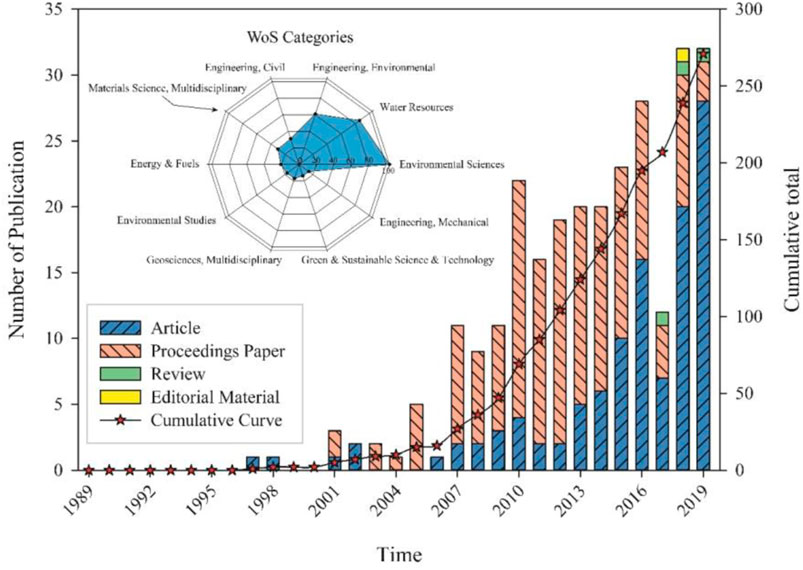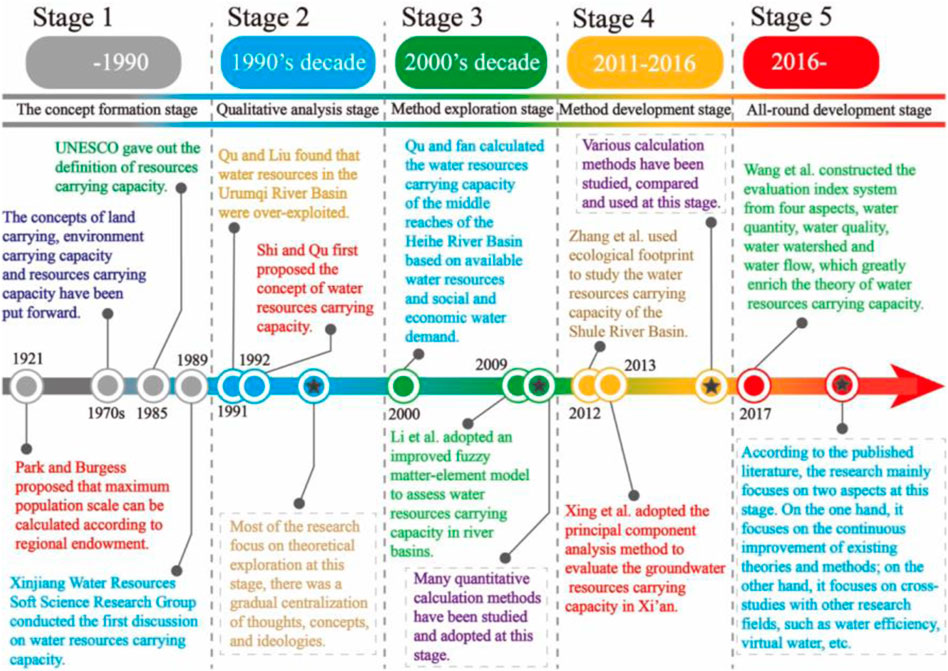- 1Research Center on Flood and Drought Disaster Reduction, China Institute of Water Resources and Hydropower Research, Beijing, China
- 2Development Research Center of the Ministry of Water Resources of P.R.China, Beijing, China
- 3Jiangxi Academy of Water Science and Engineering, Nanchang, China
Water Resources Carrying Capacity is an important indicator of water sustainable and economic development, yet few studies investigated a bibliometric analysis of Water Resources Carrying Capacity research. In this research, we proposed a four-staged bibliometric analysis method for Water Resources Carrying Capacity studies following the René Descartes’s Discourse on the Method guidelines which makes the bibliometric analysis process more systematic. Our four-staged bibliometric analysis method contains a refined screening process of the records, which can successfully delete poorly correlated data from tens of thousands of data within a short period of time and determined the subject-related data. The screening results shortlisted 271 records from an initial 16,769. We further conducted a complete bibliometric, statistical and meta-analysis of the 271 records. The results showed that China is the major country that conducts research on Water Resources Carrying Capacity. Modeling in various forms and system dynamics are the mainstream methods of Water Resources Carrying Capacity research. Water Resources Carrying Capacity is intrinsically linked to population carrying capacity, groundwater resources, urbanization and water shortage. Based on a comprehensive analysis of the research of Water Resources Carrying Capacity, we divided the research progress into five stages lastly. The method proposed in this research can provide reference for future bibliometric studies.
1 Introduction
1.1 Research backgound
Water resources are an important part of the natural environment and guarantee the development of the human society and economy. However, the distribution of water resources in space and time is often uneven. Rapidly developing and densely populated areas need more water resources but due to their uneven distribution, water resources in some areas cannot satisfy the local human population and economic demand for water (Yu et al., 2017). In this regard, it is important to pay attention to the relationship between the supply and consumption of water resources to be able to balance interaction between the two. Studying the relationship between water supply and consumption, that is, focusing on the water resources carrying capacity, is of great significance for the sustainable use of water resources within a certain region. Concern on sustainable use of water resources has increased due to the unprecedented growth and expansion of global economies within the last 3 decades that has placed an insatiable demand on water resources (Wu et al., 2020; Bian et al., 2022a). Hence, it important to comprehensively study Water Resources Carrying Capacity (WRCC) to be able to achieve an efficient water related sustainable management.
1.2 Literature review and research gap
The concept of carrying capacity began in the study of physics and refers to the maximum load that an object can bear before any irreversible deformation occurs (Dhondt, 1988). Carrying capacity was however introduced from biology where it was applied in the study of wild animals (Young, 1998; Malthus, 1798). In 1921, Park and Burgess (Park and Burgess, 1921) re-invented the idea to calculate the maximum population that can be carried by a specific area from an ecological perspective based on the supply of objects and the state of natural and social resources in a specific period. From hence, carrying capacity has been applied in the field of ecology (Mcnaughton and Wolf, 1970; Kessler, 1994).
From early 1970, population and economic expansion, which sustained for 30 years, created a contradiction between social development and environmental sustainability and this triggered a worldwide exploration of the issue of Resources and Environmental Carrying Capacity (RECC). Afterwards, other concepts such as Land Carrying Capacity (Shi et al., 2013), Environmental Carrying Capacity (Li et al., 2019), and Resource Carrying Capacity (Wang et al., 2020) emerged, peaking research on carrying capacity.
In 1985, the United Nations Educational, Scientific and Cultural Organization (UNESCO) (UNESCO&FAO, 1985) proposed the definition of Resources Carrying Capacity. Onwards, from then, carrying capacity has become one of the main contents of the concept of sustainable development (Bolis et al., 2017). In 1995, Arrow, the Nobel laureate in economics, and other well-known economists and ecologists (Arrow et al., 1995) published an article “Economic Growth, Carrying Capacity and Environment” in “Science”, which greatly improved the sustainable development and cataloged carrying capacity research in the scientific community.
WRCC is an extension of the concept of carrying capacity in the field of water resources, and belongs to a research aspect of Resources Carrying Capacity. WRCC research mainly originated in China. Though studied in other parts of the world at the time, scholars elsewhere regarded WRCC as part of the contents of sustainable development research and described it with terms such as available water and limits of river development (Falkemark and Lundqvist, 1998; Jonathan, 1999; Rijisberman and Frans, 2000; Gleick and Palaniappan, 2010; Zhu et al., 2010). An official scientific study of WRCC began in the late 1980’s when the Xinjiang Water Resources Research Group met to discuss WRCC (XWRSSRG (Xinjiang Water Resources Soft Science Research Group), 1989). In 1990s, the concept of WRCC was clearly put forward by Shi Yafeng, an Academician of the Chinese Academy of Sciences (Shi and Qu, 1992). WRCC is about the relationship between the carrying “subjects” and the ‘objects’ in the “water resources-ecological environment-social economy” system, and whether the load generated by the objects exceeds the supporting capacity of the subjects.
After nearly 30 years of exploration and development, a large number of scientific research results have been discovered in the research of WRCC which has increasingly become a hot issue in regional water resources management. Early researches on WRCC mostly focused on cities (Yue et al., 2015; Dai et al., 2019; Yang et al., 2019), provinces (Huang et al., 2014; Yang and Ding, 2018; Deng et al., 2019; Zhu et al., 2019) and river basins (Yang et al., 2010; Wu et al., 2018a; Meng et al., 2018; Wang et al., 2018; Kang et al., 2019). With the continuous deepening of research on WRCC, especially in recent years, its research objects have also changed. More and more researches have begun to focus on the study of WRCC of some typical regions including arid and semi-arid areas (Wang et al., 2010; Xie et al., 2014; Li and Zhang, 2016; Qi et al., 2016; Xiao et al., 2017), urbanized regions (Gao, 2017), lake basins (Lei et al., 2013), water-deficient regions (Wang et al., 2014), karst regions (Bo et al., 2016; Yang et al., 2016; Li et al., 2018), mining areas (Chi et al., 2019), industrial park (Kang and Xu, 2012), islands (Cao et al., 2014; Kuspilić et al., 2018) and wetlands (Wang et al., 2017). While other studies have shown interest in WRCC research for certain specific periods, for example, some studies concentrate on WRCC of arid rangelands during the droughts (Accatino et al., 2017).
Calculation methods of WRCC have evolved over the study period. New methods including back propagation model (Yang and Han, 2011), matter element analysis (Gao et al., 2013), grey clustering (Gao and Sun, 2018), state-space method (Tang et al., 2016), support vector machines (Zhang et al., 2008), analytic hierarchy process (Zhang et al., 2014; Chi et al., 2019), set pair analysis (Fu et al., 2008; Liu et al., 2018), multi-objective programming model (Wang and Zeng, 2013), metabolic theory (Ren et al., 2016), ecological footprint (Zhang and Li, 2012; Wang et al., 2017; Li et al., 2018; Dai et al., 2019; Yang et al., 2019), system dynamic model (Wang et al., 2014; Yang et al., 2015; Song, 2016; Fang, 2018; Sun and Yang, 2019), catastrophe theory (Chen et al., 2010; Song et al., 2020), cloud model (Cheng et al., 2018) and neural network (Lu et al., 2009; Wang, 2015) have been discovered. Some methods are a combination of two or three, such as, neural network and projection pursuit (Zhao, 2012); inexact fuzzy and multi-objective programming model (Wang and Zeng, 2013); analytic hierarchy process and fuzzy discrimination method (Chi et al., 2019); set pair analysis and entropy weight method (Cui et al., 2018); maximum entropy and entropy weight (Li et al., 2019); fuzzy set pair analysis model (Liu et al., 2018); combination weights and entropy principles (Zhou et al., 2017) and grey neural network model (Zheng et al., 2016).
The development and expansion of WRCC also witnessed the evolution of another concept of WRCC known as Water Resources Carrying State (WRCS) (Jiao and Liang, 2006; Ye et al., 2018). WRCC and WRCS are similar but differ slightly. Although the research on WRCC and WRCS both focus on the supply and demand of water resources within a certain area, WRCC tends to pay more attention on the larger economy and population that water resources in a certain area can support, making WRCC a threshold concept, while WRCS focuses on the balance between water supply and demand in a region.
1.3 The main work and innovations
Although the research on WRCC has increasingly become a hot topic in regional water resources management, bibliometric analysis of literature on it are still very limited (Zhang and Wang, 2012; Jin et al., 2019). Bibliometric analysis of the research on WRCC can clarify the development context and knowledge base, understand the development process, clarify the research progress, define research trends and provide scientific reference of WRCC studies.
To do a philosophical and scientific review of literature, we adopted René Descartes’s (1596. 3. 31–1650. 2. 11) method of philosophical thinking expressed in his book, “Discourse on the Method of Rightly Conducting One’s Reason and of Seeking Truth in the Sciences” (Discourse on the Method, in French: Discours de la méthode pour bien conduire sa raison, et chercher la vérité dans les sciences) (80). Based on his philosophical concept, René Descartes proposed a four-staged method of researching a problem which he categorized into the following: 1) The doubt stage, 2) The partition of problem stage, 3) Sequencing of thoughts and problem-solving stage, and 4) The comprehensive inspection and review stage (Wikiquote contributors, 2020b). These four stages have important guiding significance for both scientific research and social practice, and thus have been widely researched and used in other studies, however, to our knowledge, no study has yet applied this thinking in bibliometric analysis. The basis of theoretical analysis is lacking in most bibliometric studies.
While conducting studies on bibliometric analysis, researchers often have to deal with thousands of records, some, not closely related with the topic under study. Some researchers perform manual screening of records directly (Tao et al., 2020), which consumes large quantities of time. And some of the studies even lack the process of screening (Huang et al., 2020; Mallawaarachchi et al., 2020; Secinaro et al., 2020), which will lead to less credibility of the results. Since finding out the subject-related records can be very time consuming, an efficient method that can quickly and precisely sort-out topic-related records within a short period of time is necessary. Consequently, we proposed a refined literature screening process to effectively and efficiently sort out relevant from irrelevant literature.
This article aims to sort out and summarize the research on WRCC through bibliometric analysis. The remaining parts of the article are structured as follows: the second part introduces the retrieval process, the records screening method and the analysis process; the third part analyzes and discusses the results of the bibliometric analysis and statistical analysis of WRCC; the fourth part summarizes the full text, and prospects for future development of research on WRCC.
2 A four-staged bibliometric analysis for WRCC
René Descartes’s Discourse on the Method has been used as a general guideline, by which we build the framework of this research. Section 2.1 shows how we applied Descartes’s four-staged methodology. Due to the macroscopic nature of Descartes’s methodology, it is difficult to guide the specific steps (Wikiquote contributors, 2020b). According to the specific process of bibliometric analysis, and based on Descartes’s methodology, we also divided the concrete steps of bibliometric analysis into four stages in this research (Section 2.2).
2.1 René descartes’s Discourse on the Method and application
In Descartes’s book Discourse on the Method, he proposed the true method by which to arrive at the knowledge of whatever lay within the compass of his powers, and he summarized this method into four stages (Figure 1). These include: 1) The doubt stage in which ideas are scattered and uncoordinated, and knowledge is based only on what is read; 2) The partition of problem stage, where difficulties are broken down to pieces for easy understanding; 3) The sequencing of thoughts and problem solving stage, where by starting from the simple to the complex, difficult situations are organized in an explicit way for easy understanding and problem-solving; 4) The comprehensive inspection and review stage where enumerations are completed while ideas and thoughts are presented in an orderly and concise review (Wikiquote contributors, 2020b).
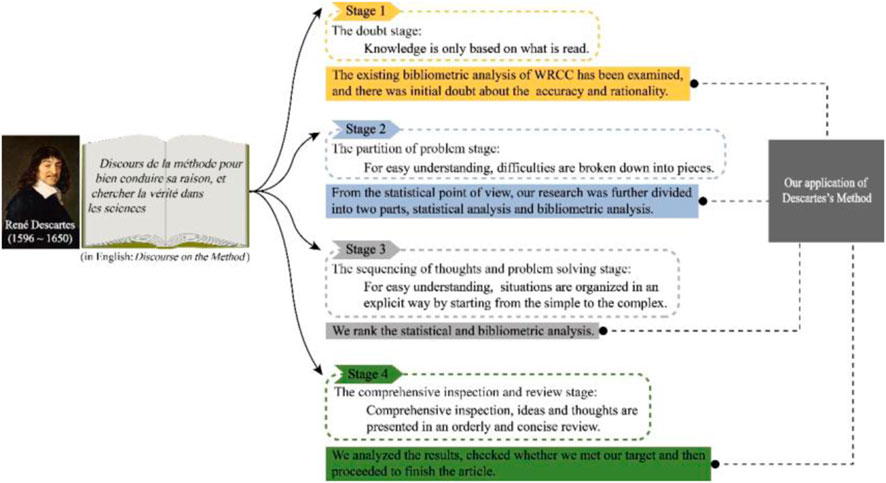
FIGURE 1. Framework and application of René Descartes’s Discourse on the Method. Source of René Descartes’s portrait: image.baidu.com.
Putting René Descartes’s study into perspective, in the first stage (Figure 1.) of this study where we examined the existing bibliometric analysis of WRCC, there was initial doubt about the rationality and accuracy of existing bibliometric research on WRCC. We found that the existing bibliometric analysis of WRCC were not systematic, lacked coherency and were not comprehensive. This confirmed our earlier assertion that bibliometric research on WRCC is limited. Only two studies by Zhang and Wang (2012) and Jin et al. (2019) have done a bibliometric analysis of WRCC. Zhang and Wang (2012) only conducted a bibliometric analysis of Chinese literature, and ignored the bibliometric analysis of English literature. Their paper is archaic ((Zhang and Wang, 2012), was published 8 years ago), and does not reflect the bibliometric analysis of current WRCC research. Even though Jin et al. (2019) was published recently, their work lacks a detailed screening process of the records (data) and also lacks rationality and accuracy of the results. The above two scenarios are part of the foundations of this research.
In the second stage of applying René Descartes’s philosophy, we broke the WRCC bibliometric analysis into several units consisting literature retrieval, records screening and analysis. From the statistical point of view, our research was further divided into two parts, statistical analysis and bibliometric analysis.
In the third stage, though we needed to rank the steps, since literature retrieval, records screen and records analysis cannot be re-ranked as literature retrieval should always come first followed by records screening and then analysis records, we chose rather to rank the statistical and bibliometric analysis. We found that statistical analysis was easier compared to bibliometric, so we finished the statistical analysis and then conducted a bibliometric analysis.
In the fourth stage, we analyzed the results, checked whether we met our target and then proceeded to finish the article.
2.2 Four stages of bibliometric analysis of WRCC
Because it can be better understood and thus can be widely used, staged method has attracted more researchers’ attention in recent years (Wu et al., 2018b2018; Bian et al., 2022b). René Descartes’s method can be concluded into four stages, therefore, we divide our research process also into four stages. Since each of literature retrieval, records screening and records analysis stages are very complicated and contain several steps, we treated them separately. We further divide the concrete steps of bibliometric analysis of WRCC into four stages. And the details of our four-staged bibliometric analysis proposed in this research is shown in Figure 2.
The four stages of bibliometric analysis are elaborated as follows:
Stage 1: The choice of search terms and search strategies is very important, and directly determines whether the search results are comprehensive. Many terms can be used to express the meaning of WRCC, therefore, using a single term will not present comprehensive results. In order to acquire more comprehensive search results, in the first stage, multiple search terms should be selected.
Stage 2: In the search process, files with poor relevance to the topic will inevitably be retrieved. The search results need to be accurately and carefully screened. In order to obtain more accurate topic-related results, this study proposed a refined literature screening process, which is a three-stepped screening method (Figure 2. Stage 2: The screening methods are done through records category, relevance, and manual. By adopting this three-stepped screening method, we can extract the topic-related records from even tens of thousands of records in a short period of time.
Stage 3: We analyzed all the topic-related records by using both statistical analysis and bibliometric analysis at the same time.
Stage 4: We analyzed all the results comprehensively, we checked whether we meet our target and finished this article.
2.2.1 Literature retrieval
In this study, the Web of Science Core Collection Database was explored in advanced search page, using Boolean Logic to search TS = (water carrying capacity OR water resources carrying capacity OR water bearing capacity OR water resources bearing capacity OR water resource bearing capacity) in which the subject contains “water carrying capacity”, “water resources/resource carrying capacity”, “water bearing capacity” or “water resources/resource bearing capacity”. The retrieval year ranges from 1989 to 2019 (in 1989, WRCC was discussed for the first time, but the concept of WRCC was not yet proposed). A total of 16769 records were obtained. The retrieval time is August 15, 2020.
2.2.2 Records screening
During the search process, some files irrelevant to the topic will inevitably be retrieved. Therefore, the search results need to be accurately and carefully screened. In order to obtain more accurate search results, this study adopted a three-stepped screening method. The specific screening steps were applied as follows: 1) The first screening explored 16769 results through Web of Science and selected the category that is related and similar to WRCC, For example, in this research, we click “Result Analysis” on the search results interface of Web of Science, and selected “Environmental Science”, “Water Resources”, “Engineering environmental”, “Ecology”, “Green sustainability science” in the “Web of Science category on the result analysis interface technologyv”, “Multidisciplinary sciences”, “Environmental studies”, “Computer science interdisciplinary applications”, “Mathematics applied”, “Urban studies”, “Management”, 5678 records were obtained. 2) The second step is to screen 5678 search results through the relevance function of the Web of Science webpage. The 5678 search records obtained after screening were sorted in order of relevance, and it was found that the top 500 records all contained “water”, “carrying”, “capacity” or “water”, “bearing”, “capacity” in their topics. After the first 500, the records no longer contained, in relevant application, usage of the words “water”, “carrying”, “capacity” or “water”, “bearing”, “capacity”. Therefore, we concluded that the content after first 500 files does not contain relevant literature related to WRCC. 3) The third step of screening was to manually check the contents of the first 500 records one after the other. During the search, the fact that “water”, “carrying”, “capacity” or “water”, “bearing”, “capacity”, appears in the title of an article doesn’t necessarily mean its research content belongs to the research category of WRCC, therefore the 500 records need to be manually checked, For example, “tourism water resources carrying capacity”, “groundwater carrying capacity”, “water resources and water environment carrying capacity”, and “agricultural water resources carrying capacity ” all belong to the research category of WRCC. However, though “soil water carrying capacity”, “sediment carrying capacity of river flow”, “carrying capacity of fishpond”, “stock carrying capacity”, “recreation carrying capacity”, “mineral resources carrying capacity”, all include the words “water”, “carrying”, “capacity” or “water”, “bearing”, “capacity” in their topics, they do not belong to the research of WRCC. We can see that due to the similarity of some research content, in order to obtain more accurate data in bibliometric research, it is very necessary to finely screen results. After the three-stepped screening process, a total of 271 records were obtained (Appendix A).
2.2.3 Records analysis
The data export of this study is divided into two parts: 1) In the first part, we added the 271 records to the Marked List on the Web of Science website, and then exported important information such as “title”, “author”, “source publication”, “cited frequency”, “document type” and “keywords” to an excel file. 2) In the second part, we directly exported the “full records and cited references” of 271 records on the Web of Science website to plain text files.
In processing of excel file data, we first sorted out the information in the exported excel file starting with the year, country, journal and number of author’s publications. We then sorted out the top 30 highly cited articles, extracted the methods used in the articles and finally marked the time these methods were first used.
In dealing with the plain text files, we first analyzed the exported text file through the VOSviewer software. The results of keywords co-occurrence analysis, inter-year changes of keywords and heat maps were obtained. VOSviewer is a software tool for constructing and visualizing bibliometric networks, which has been developed by Nees Jan van Eck and Ludo Waltman at Leiden University’s Centre for Science and Technology Studies (CWTS) (http://www.vosviewer.com/).
2.2.4 Comprehensive analysis
In order to have a more comprehensive understanding of the nature of research progress and current research state of WRCC, we adopted the comprehensive analysis method to further analyze the results obtained from the bibliometric analysis of WRCC in this stage. We also checked whether we met our target, which means that whether we have completed a systematic and comprehensive bibliometric analysis-review of WRCC in this stage. The volume of published literature and research progress have been analyzed, and stages of the development process of WRCC divided.
3 Results and discussion
In this section, both statistical and bibliometric results have been fully analyzed and discussed, and a comprehensive analysis has also been conducted lastly. 3.1 presented the number of articles published by country, periods and authors, and statistical analysis of methods; Section 3.2 analyzed the highly cited papers; 3.3 analyzed the keywords co-occurrence and research hotspots dynamics; and Section 3.4 analyzed WRCC development comprehensively.
3.1 Statistical analysis of articles and methods
Number of articles by country, periods and authors are shown in Figure 3.
Number of publications by country indicates that China published the highest number of papers followed by Indonesia, Germany, Algeria and other (Figure 3A) in that order. China has the largest number of publications for two reasons: firstly, WRCC was put forward by the Chinese, and Chinese scholars have shown more research interest in this area. Secondly, due to rapid infrastructural and economic expansion witnessed by China in the last 30 years, demand for water resources has tripled and placed a huge deficit on water need. To avert this situation, the Chinese government attached great importance on WRCC research by setting up a number of National Natural Science Foundation Projects including “Innovative Research On Water Resources Carrying Capacity Based On Water Scarcity Risk Model” (approval number: 40771044), “Research On the Dynamic Mechanism And Sustainability Of the Evolution Of Water Resources Carrying Capacity Under the Framework Of Quality-Energy” (approval number: 41061053), “Risk Analysis Of Economic Development Planning Based On Water Resources Carrying Capacity Under Uncertain Conditions” (approval number: 41271536). The establishment of these National Natural Science Foundation Projects directly and vigorously promoted the research and development of WRCC.
Results of number of papers published by journals indicated that, the top 30 journals with the most papers on WRCC research are in the order shown in (Figure 3B). They include ADV MATER RES, APPL MECH MATER, IOP C SER EARTH ENV, AER ADV ENG RES, J CLEAN PROD, WATER-SUI, WATER RESOUR MANAG, ECOL INDIC, J GROUNDW SCI ENG and PROCEDIA ENVIRON SCI. The number of articles published in the order in which the journals are listed above are: 26, 11, 10, 9, 8, 8, 7, 4, 4, and 4 respectively.
From number of articles published by authors perspective, the top 30 authors with the most articles and the number of articles published are shown in (Figure 3C). The top 10 authors with the most articles include Feng, Lihua, Lei, Kun, Meng, Lihong, Berezowska-Azzag, Ewa, Fu, Qiang, Gao, Yang, Luo, Gaoyuan, Su, Haimin, Wang, Xin, Wang, Zilong. Among them, Feng, Lihua, Lei, Kun, Meng, Lihong published 4 articles each while the remaining 7 authors published 3 articles each.
By analyzing the excel files exported from the Web of Science website, we discovered 47 methods from 271 articles used in WRCC calculation and evaluation (Figure 4).
In Figure 4, the methods include TOPSIS, system dynamics model, support vector machines, state-space, set pair analysis, neural network, ecological footprint, cloud model, analytic hierarchy process-fuzzy discrimination, inexact fuzzy multi-objective programming model, etc. have been used in WRCC research.
3.2 Analysis of highly cited papers
In sorting citations of the 271 articles retrieved, we first checked the title of the article, author, publication year, journal source, and number of citations of the top 30 articles with the most citations (as of August 14, 2020) Table 1.
From Table 1, the top 5 documents were all within the period from 2008 to 2014. This period belongs to the research and development stage of WRCC study. Two of the five articles were published in 2008, and one each in 2009, 2011 and 2014. The number of citations of the 5 articles are in the order 109, 91, 76, 73, 70. Among the 5 articles, 3 are from WATER RESOUR MANAG, MATH COMPUT SIMULAT and ECOL MODEL, indicating that the journal WATER RESOUR MANAG plays an important role in publishing WRCC papers, and papers published in this journal have a greater impact. It can be seen intuitively from the titles that three of the articles are studied in cities in China including Tianjin, Yiwu, and Siping and the other two articles equally studied in China (Feng and Huang, 2008; Gong and Jin, 2009) in Lanzhou and Jinhua Cities. This confirms results of earlier analysis that China was the country with the highest number of research work on WRCC.
3.3 Keywords co-occurrence and hotspots dynamics analysis
Keywords can reflect the main content of the article, and the analysis of keywords can understand the general status of the research field. When using VOSviewer software to analyze the co-occurrence of keywords, the larger the node means the more frequently the keyword appeared (Figure 5). The width of the connection between nodes can reflect the frequency of two connected keywords. The wider the connection indicates that the two keywords appear more frequently.
The results shown in Figure 5 indicate that the most frequently occurring keywords are “water resources carrying capacity”, “carrying capacity”, “management”, “water resources”, “system dynamics”, “model”, and “sustainable development”, “Sustainability”, “china”, “river-basin” etc. From the perspective of the width of the connection between nodes, the connection between water resources carrying capacity and management and sustainable development is wider, and the connection between China and river-basin is wider. It shows that these two groups of keywords appear more frequently at the same time.
From the clustering results, the water resources carrying capacity node is the largest among all, which is shown in green. The yellow node emphasizes the methods, the main two yellow nodes are model and system dynamics. The blue node focuses on the research objects, and the two main blue nodes are China and river-basin. The red nodes focus on management, and the main red nodes are management, sustainability, sustainable development, carrying capacity and water resources.
In the analysis of keywords co-occurrence in papers related to water resources carrying capacity, the most frequently occurred keyword is “water resources carrying capacity”. Many nodes are directly connected to “water resources carrying capacity”, and other nodes are connected to this node through intermediate nodes. The nodes that are most closely connected to the water resources carrying capacity node are the management node and the sustainable development node (Figure 6.). The carrying capacity of water resources is an important means for water resources management and an important measure for achieving sustainable development of water resources.
From the results of cluster analysis, the red nodes emphasize water resources management. The number of nodes connected to the management node and the sustainable development node is greater than the number of nodes connected to the water resources node and the carrying capacity node (Figures 7A–D). This is because more nodes are connected to the water resources carrying capacity node, the number of nodes connected to the water resources node and the carrying capacity node is relatively reduced. It is worth noting that the largest node connected to the management node and the sustainable development node is the water resources carrying capacity node, and the width of the connection with this node is the widest, indicating that they have the largest frequency of co-occurrence.
Analysis results of research methods indicates that the most frequently occurring research methods in the keyword co-occurrence graph are model and systems dynamics. This means that building various models and adopting system dynamics in the research process of WRCC are mainstream. Many nodes are closely connected to these two nodes (Figures 8A,B). Water resources carrying capacity, carrying capacity, and management are the nodes that are most closely connected to the model node and the system dynamics node. At the same time, the model node and the system dynamics node are also the most closely connected nodes to each other. This shows that these nodes appear more frequently at the same time. In the analysis of keywords co-occurrence, China is the only country that appeared. River basin is the only node closely connected to China (Figure 8C). Furthermore, China is the only node closely connected to the river-basin node (Figure 8D). It can be seen that the number of nodes connected to the China node and the river-basin node is significantly less than the number of nodes connected to the model node and the system dynamics node, indicating that more research on WRCC tends to be methodological innovation and application, while research on WRCC in some specific areas is relatively lacking.
From the keywords co-occurrence density map, we can clearly find research hotspots in the field. The density map of WRCC keywords co-occurrence in this study is shown in Figure 9.
In Figure 9, apart from water resources carrying capacity, there is also carrying capacity, water resources, management, sustainable development, model, China, system dynamics, and other hot spots in the field of WRCC research. WRCC is an important method to realize the sustainable use of water resources and an important means to realize the effective management of water resources. Therefore, these three words, sustainable development, management, and water resources often appear in the keywords of research papers on WRCC. These three words are hot topics in the research of WRCC. WRCC and land resources carrying capacity belong to the research category of resources carrying capacity, therefore carrying capacity is also a hot vocabulary in the research scope of WRCC. China was the only count name of a country that appeared in Figure 9, which again confirms the assertion that China is the main country in the study of WRCC. It can also be seen from Figure 9 that model and system dynamics are the commonest vocabularies, meaning that a lot of research is carried out by building models or using system dynamics methods to study WRCC.
The time sequence analysis of keywords can reflect the changes of researchers’ interest in some aspects to a large extent. Therefore, time sequence analysis of keywords helps to clarify the development context and knowledge base of the concept. This study conducted a time series analysis on the keywords of WRCC. The analysis results are shown in Figure 10. The darker the color of the node, the longer the research time in this area. The lighter the color of the node means that the research in that area is the current hotspot.
From the perspective of time series analysis of the keywords of WRCC, WRCC is gradually generated and developed from scholars’ attention to population carrying capacity, groundwater resources, urbanization, water shortage, risk assessment, etc, (Figure 10 regions A, B). From the perspective of the spatial scale of WRCC research, the evaluation of WRCC initially focused on the study of cities and provinces. As the research continued to deepen, scholars began to pay more attention to the impact of WRCC on regional water resources. The guiding significance of the deployment, is that the research scale of WRCC has begun to gradually shift to the basin scale (regions C and D in Figure 10).
3.4 Comprehensive analysis of WRCC development
The overall situation of the number of papers retrieved in the core database of Web of Science is shown in Figure 11.
From Figure 11, we can see that although the search period is set from 1989 to 2019, the search results indicated that the earliest literature on WRCC from Web of Science Core Database was published between 1997 and 1998. Within this period Joardar and other scholars comprehensively considered natural resources and social resources, established a set of index system for calculating water supply capacity, and used it for the calculation of urban carrying capacity to provide help for the formulation of urban development plans (Joardar, 1998). As research advanced, the number of published papers increased by the year. At the concept proposition stage as well as the early exploration stage, the number of articles published was relatively few and almost all were written in Chinese. Therefore, no articles were retrieved in the Web of Science Core Database for this time. From 2000 to 2010, the number of articles published increased. This however decreased slightly in 2011 compared with 2010, and maintained a steady upward trend from 2011 to 2016. In 2017, both the number of articles and the number of proceeding papers decreased significantly. From 2018 to 2019, the number of papers increased significantly and the types of articles became more diverse. Articles on editorial materials and review papers appeared at this stage. In general, the number of articles published on WRCC has been increasing meaning that studies on WRCC has received attention over the past 3 decades. From the WoS (Web of Science) Categories analysis result shown in Figure 11, we can see that most of the WRCC research belong to two categories, Environmental Sciences and Water Resources.
Results on types of papers published indicates that 41.7% are articles while editorial materials and reviews account for 1.5%. Conference and other meetings proceedings papers account for a large proportion of papers published on WRCC research. The period from 2007 to 2016 recorded the most numerous proceeding papers published per year, indicating that a large number of proceeding papers published have played an important role in the development of WRCC.
Based on research progress, the volume of published literature, period at which calculation methods were proposed, and our knowledge in WRCC research, this paper divides the research progress of WRCC into five stages (Figure 12).
These five stages have been further elaborated as follows:
• The concept formation stage (-1990). Park and Burgess (1921) took the lead in 1921 and proposed the idea to calculate the maximum population that a region can carry based on regional endowments. Later, other scholars and institutions have successively proposed concepts that are closely related to the WRCC, such as resources carrying capacity, environmental carrying capacity. In 1989, the Xinjiang Water Resources Research Group (XWRSSRG (Xinjiang Water Resources Soft Science Research Group), 1989) completed the first discussion on the issue of WRCC which laid a solid foundation for the concept of WRCC.
• The second stage is the qualitative analysis period (1990s decade). Most of the research in this period focused on the qualitative description stage, while the number of papers on quantitative research is relatively limited. Qualitative research mostly elaborates its theoretical basis and important significance. In 1992, Academician Shi Yafeng clearly put forward the concept of WRCC for the first time (Shi and Qu, 1992). Wang et al. (1999) conducted an in-depth discussion on the concept and theory of WRCC. Cai (1994) elaborated on the issues that needed attention in the study of WRCC in Xinjiang.
• At the methods exploration stage (2000s decade), many quantitative analysis methods have been proposed and applied, For example, Qu and Fan (2000) analyzed and calculated the WRCC in the middle reaches of the Heihe River Basin based on available water resources as well as social and economic water requirements. Li et al. (2009) used an improved fuzzy matter-element model to evaluate water resources carrying capacity. However, in the 10-year exploration stage of the method, only 9 of the 47 methods (47 methods extracted in Section 3.1) were proposed and applied at this stage.
• During the method development period (2011–2016), a large number of research methods have been introduced into the evaluation and research process of WRCC, For example, Zhang et al. (2012) used the ecological footprint method to study the WRCC of the Shule River Basin; Xing et al. (2013) used the principal component analysis method to evaluate ground WRCC of Xi’an from 7 indicators. At this stage, which extends 6 years, 20 methods out of 47 methods have been proposed and applied. The speed of progress at this stage was much faster than the method exploration stage. This study defines this stage as the method development stage.
• The fifth stage is referred as the all-round development stage (2016-). On one hand theoretical system of WRCC has been further enriched and improved, For example, Wang et al. (2017) first constructed an evaluation index system for WRCC from the four aspects of “quantity, quality, region and flow”. At the other hand, application of the methods has also been expanded to a greater extent. Among the 47 methods, 18 methods have been proposed and applied at this stage, and the time limit from this stage to the study of this review is only 3 years. This explains that more methods were applied at this stage. At the same time, most of the subtle changes (Introduction paragraph 6) that occurred in the evaluation objects of WRCC all occurred at this stage. Based on this precept, this stage is defined as the all-round development stage of WRCC.
4 Conclusions and prospects
In this review, a four-staged bibliometric analysis method was used based on the René Descartes’s Discourse on the Method. This makes the bibliometric research process more systematic and efficient compared to previous studies. The four-staged bibliometric analysis method proposed in this research is equipped with a records screening stage, in which we proposed a three-stepped screening method, that solved the problem of large file sorting. Through the three-stepped screening method proposed in this research, it was possible to finally determine the document records highly related to the research topic from tens of thousands of records within a short period of time.
The bibliometric analysis - review results show that a total of 47 methods including system dynamics, cloud model, set pair analysis, neural network and ecological footprint have been introduced into the evaluation process of WRCC. Through keyword co-occurrence analysis, we found that building various kinds of models and adopting system dynamics methods are the mainstream methods in the research of WRCC. We also found that China is the only country that appears in the keywords co-occurrence analysis chart, which shows that China is the main country in the study of WRCC. Through time series analysis of keywords, we found that the research on WRCC originated from scholars’attention to population carrying capacity, groundwater resources, urbanization, water shortage and risk assessment. From the perspective of research objects, previous studies have focused more on some provinces and cities. In recent years, more and more scholars have begun to study the WRCC of some typical regions, such as arid and semi-arid regions, urbanized areas and water-deficient regions. Based on the research status, the amount of published literature over time, the analysis of the time when the method was first adopted, and our knowledge in this area, this study divided the development process of WRCC into the concept formation stage, qualitative analysis stage, method exploration stage, method development stage and all-round development stage.
Author contributions
XY contributed to conception and design of the study. FL organized the database. YQ performed the statistical analysis. BS, XY wrote the first draft of the manuscript. All authors contributed to manuscript revision, read, and approved the submitted version.
Acknowledgments
Thanks to the National Key Research And Development Program funded project 2021YFC3000203, and the Ministry of Water Resources' flood and drought disaster prevention strategy research talent innovation team project WH0145B042021.We also would like to extend special thanks to the editor and the reviewers for their insightful comments and constructive suggestions.
Conflict of interest
The authors declare that the research was conducted in the absence of any commercial or financial relationships that could be construed as a potential conflict of interest.
Publisher’s note
All claims expressed in this article are solely those of the authors and do not necessarily represent those of their affiliated organizations, or those of the publisher, the editors and the reviewers. Any product that may be evaluated in this article, or claim that may be made by its manufacturer, is not guaranteed or endorsed by the publisher.
Supplementary material
The Supplementary Material for this article can be found online at: https://www.frontiersin.org/articles/10.3389/feart.2022.970582/full#supplementary-material
References
Accatino, F., Ward, D., Wiegand, K., and De Michele, C. (2017). Carrying capacity in arid rangelands during droughts: The role of temporal and spatial thresholds. Animal 11 (2), 309–317. doi:10.1017/S1751731116001531
Arrow, K., BolinCostanza, R., Dasgupta, P., Folke, C., and Holling, C. S. (1995). Economic growth, carrying capacity, and the environment. Science 268, 520–521. doi:10.1126/science.268.5210.520
Bian, D., Yang, X., Wu, F., Babuna, P., Luo, Y., Wang, B., et al. (2022). A three-stage hybrid model investigating regional evaluation, pattern analysis and obstruction factor analysis for water resource spatial equilibrium in China. J. Clean. Prod. 331, 129940. doi:10.1016/j.jclepro.2021.129940
Bian, D., Yang, X., Xiang, W., Sun, B., Chen, Y., Babuna, P., et al. (2022). A new model to evaluate water resource spatial equilibrium based on the game theory coupling weight method and the coupling coordination degree. J. Clean. Prod. 366, 132907. doi:10.1016/j.jclepro.2022.132907
Bo, L., Qiang, W., and Li-xia, C. (2016). An analytical method of regional water resources carrying capacity in karst area – A case study in guizhou province, China. Water pract. Tech 11 (4), 796–805. doi:10.2166/wpt.2016.085
Bolis, I., Morioka, S. N., and Sznelwar, L. I. (2017). Are we making decisions in a sustainable way? A comprehensive literature review about rationalities for sustainable development. J. Clean. Prod. 145, 310–322. doi:10.1016/j.jclepro.2017.01.025
Cai, A. (1994). A Brief Talk on Water Resources Carrying Capacity──A few issues that should be paid attention to in the study of appropriate water resources carrying capacity in Xinjiang. Environ. Prot. Xinjiang 04, 190.
Cao, J. K., Zhang, J., and Ma, S. Q. (2014). “The analysis of water resource ecological carrying capacity of Hainan international island,” in Ecosystem Assessment and fuzzy systems management (Cham: Springer), 63–71. doi:10.1007/978-3-319-03449-2_7
Chen, N. X., Qu, J. H., Xu, J. X., Li, Z. P., and Yang, L. (2010). “Evaluation of Groundwater Environment Carrying Capacity Based on Catastrophe Theory.” in 2010 4th International Conference on Bioinformatics and Biomedical Engineering, Chengdu, 18-20 June 2010, 1–4.
Cheng, K., Fu, Q., Meng, J., Li, T. X., and Pei, W. (2018). Analysis of the spatial variation and identification of factors affecting the water resources carrying capacity based on the cloud model. Water Resour. manage. 32 (8), 2767–2781. doi:10.1007/s11269-018-1957-x
Chi, M., Zhang, D., Fan, G., Zhang, W., and Liu, H. (2019). Prediction of water resource carrying capacity by the analytic hierarchy process-fuzzy discrimination method in a mining area. Ecol. Indic. 96, 647–655. doi:10.1016/j.ecolind.2018.09.021
Cui, Y., Feng, P., Jin, J., and Liu, L. (2018). Water resources carrying capacity evaluation and diagnosis based on set pair analysis and improved the entropy weight method. Entropy 20 (5), 359. doi:10.3390/e20050359
Dai, D., Sun, M., Xu, X., and Lei, K. (2019). Assessment of the water resource carrying capacity based on the ecological footprint: A case study in zhangjiakou city, North China. Environ. Sci. Pollut. Res. 26 (11), 11000–11011. doi:10.1007/s11356-019-04414-9
Deng, W., Yan, L., Wang, Y., Jin, X., and Hu, Y. (2019). A study on water resources carrying capacity based on water usage intensity in hainan province IOP conference series: Earth and environmental science. IOP Conf. Ser. Earth Environ. Sci. 237 (3), 032090. doi:10.1088/1755-1315/237/3/032090
Falkemark, M., and Lundqvist, J. (1998). Towards water security: Political determination and human adaptation crucial. Nat. Resour. Forum 21 (1), 37–51. doi:10.1111/j.1477-8947.1998.tb00708.x
Fang, H. (2018). “Application of system dynamics and WCCI in water resources evaluation: Taking Pakistan as an example,” in 2018 International Conference on Mechanical, Electronic, Control and Automation Engineering (MECAE 2018), Qingdao, March 30–31, 2018.
Feng, L. H., and Huang, C. F. (2008). A risk assessment model of water shortage based on information diffusion technology and its application in analyzing carrying capacity of water resources. Water Resour. manage. 22 (5), 621–633. doi:10.1007/s11269-007-9182-z
Fu, Q., Liu, D., and Wang, Z. (2008). “Evaluation of region water resources carrying capacity based on set pair analysis technology,” in 2008 4th International Conference on Wireless Communications, Networking and Mobile Computing, South Korea, 12-14 Oct. 2008, 1–4.
Gao, H., and Sun, L. (2018). Grey clustering evaluation of water resources carrying capacity based on triangle whitening weight function. IOP Conf. Ser. Earth Environ. Sci. 208, 012101. doi:10.1088/1755-1315/208/1/012101
Gao, S. (2017). Study on the bearing capacity of water resources in urbanized area. Agro Food Ind. Hi-Tech 28 (1), 3026–3029.
Gao, Y., Zhang, H. M., Xu, G. W., Su, H. M., and Zhang, Y. (2013). “Sustainable utilization evaluation on water resources base on matter element analysis in Huaibei City,” in Advanced materials research (Switzerland: Trans. Tech. Publications Ltd), 610, 2671–2674. doi:10.4028/www.scientific.net/AMR.610-613.2671
Gleick, P. H., and Palaniappan, M. (2010). Peak water limits to freshwater withdrawal and use. Proc. Natl. Acad. Sci. U. S. A. 107, 11155–11162. doi:10.1073/pnas.1004812107
Gong, L., and Jin, C. (2009). Fuzzy comprehensive evaluation for carrying capacity of regional water resources. Water Resour. manage. 23 (12), 2505–2513. doi:10.1007/s11269-008-9393-y
Huang, L., Zhou, M., Lv, J., and Chen, K. (2020). Trends in global research in forest carbon sequestration: A bibliometric analysis. J. Clean. Prod. 252, 119908. doi:10.1016/j.jclepro.2019.119908
Huang, Q., Wang, W. P., and Deng, H. Y. (2014). “Agricultural restructuring based on the water resources carrying capacity in shandong province, China,” in Applied mechanics and materials (Switzerland: Trans Tech Publications Ltd), 675, 783–786. doi:10.4028/www.scientific.net/AMM.675-677.783
Jiao, S., and Liang, H. (2006). A research on spatio-temporal characteristics of the water resource carrying status in Guiyang City. Guiyang: J. Guizhou Norm. Univ., 21–26. (in Chinese).04.
Jin, J., Chen, P., Chen, M., Li, J., Xu, C., and Chang, T. (2019). Bibliometric analysis of research progress on water resources carrying capacity based on knowledge map. Water Resour. Prot. 35, 14.
Joardar, S. D. (1998). Carrying capacities and standards as bases towards urban infrastructure planning in India: A case of urban water supply and sanitation. Habitat Int. 22 (3), 327–337. doi:10.1016/S0197-3975(98)00002-2
Jonathan, H. M. (1999). Carrying capacity in agriculture: Globe and regional issue. Ecol. Econ. 29 (3), 443–461. doi:10.1016/S0921-8009(98)00089-5
Kang, J., Zi, X., Wang, S., and He, L. (2019). Evaluation and optimization of agricultural water resources carrying capacity in haihe river basin, China. Water 11 (5), 999. doi:10.3390/w11050999
Kang, P., and Xu, L. (2012). Water environmental carrying capacity assessment of an industrial park. Procedia Environ. Sci. 13, 879–890. doi:10.1016/j.proenv.2012.01.082
Kessler, J. J. (1994). Usefulness of the human carrying capacity concept in assessing ecological sustainability of land-use in semi-arid regions. Agric. Ecosyst. Environ. 48 (3), 273–284. doi:10.1016/0167-8809(94)90109-0
Kuspilić, M., Vuković, Ž., and Halkijević, I. (2018). Assessment of water resources carrying capacity for the Island of Cres. Gradevinar 70 (04), 305–313. doi:10.14256/JCE.2167.2017
Lei, H. J., Yin, L., and Xi, B. D. (2013). “Scenario analysis on the water environment carrying capacity of wuliangsuhai lake basin,” in Advanced materials research (Switzerland: Trans Tech Publications Ltd), 616, 1388–1393. doi:10.4028/www.scientific.net/AMR.616-618.1388
Li, B., Wang, X., Wei, T., Zeng, Y., and Zhang, B. (2018). Analysis of sustainable utilization of water resources in karst region based on the ecological footprint model–Liupanshui city case. J. Water Supply Res. Trans. 67 (6), 566–575. doi:10.2166/aqua.2018.016
Li, C., Li, H. J., Feng, S. D., Liu, X. Y., and Guo, S. (2019). A study on the spatiotemporal characteristics and change trend of the atmospheric environmental carrying capacity in the Jing-Jin-Ji region, China. J. Clean. Prod. 211, 27–35. doi:10.1016/j.jclepro.2018.11.045
Li, J., Yang, X., and Lu, G. (2009). Fuzzy matter-element model based on improved membership degree for comprehensive assessment of water resources carrying capacity in river basins. J. Hydroelectr. Eng. 28, 78–83.
Li, W. M., and Zhang, K. (2016). “Evaluation and analysis of water resources carrying capacity in arid zone—a case of manas basin,” in Water Resources and Environment Proceedings of the 2015 International Conference on Water Resources and Environment, Beijing, 25–28 July 2015 (Leiden, Netherlands: CRC Press/Balkema), 103–108.
Liu, T., Yang, X., and Song, F. (2018). “Comprehensive evaluation for water resources carrying capacity in jilin province based on fuzzy set pair analysis model,” in International Conference on Environmental and Water Resources Engineering (EWRE), South Korea, Oct 12-14, 2018.
Lu, F., Xu, J., and Wang, Z. (2009). “Application of GA optimized wavelet neural networks for carrying capacity of water resources prediction,” in 2009 international conference on environmental science and information application technology, Wuhan, China, July 4 2009 to July 5 2009, 308–311. doi:10.1109/ESIAT.2009.591
Mallawaarachchi, H., Sandanayake, Y., Karunasena, G., and Liu, C. (2020). Unveiling the conceptual development of industrial symbiosis: Bibliometric analysis. J. Clean. Prod. 258, 120618. doi:10.1016/j.jclepro.2020.120618
Malthus, T. R. (1798). An essay on the principle of population. Ann Arbor, Michigan, United States: University of Michigan Press.
Mcnaughton, S. J., and Wolf, L. L. (1970). Dominance and the niche in ecological systems. Science 167 (39), 131–139. doi:10.1126/science.167.3915.131
Meng, C., Wang, X., and Li, Y. (2018). An optimization model for water management based on water resources and environmental carrying capacities: A case study of the yinma river basin, northeast China. Water 10 (5), 565. doi:10.3390/w10050565
Park, R. E., and Burgess, E. W. (1921). Introduction to the science of sociology. Chicago: University of Chicago Press.
Qi, H., Jiang, J. Y., Ying, L. I., Shi, Z. G., and Yin, P. H. (2016). Current research status and perspective of water resources carrying capacity in the arid and semi-arid regions of northwest China. DEStech Trans. Soc. Sci. Educ. Hum. Sci. 2016, 383–390 doi:10.12783/dtssehs/icssd2016/4756
Qu, G., and Fan, S. (2000). Water resources capacity and developing strategies in Heihe River Basin. Chin. Desert 20, 1–8.
Ren, C., Guo, P., Li, M., and Li, R. (2016). An innovative method for water resources carrying capacity research–metabolic theory of regional water resources. J. Environ. Manage. 167, 139–146. doi:10.1016/j.jenvman.2015.11.033
Rijisberman, M. A., and Frans, H. (2000). Different approaches to assessment of design and management of sustainable urban water system. Environ. Impact Assess. Rev. 129 (3), 333–345. doi:10.1016/S0195-9255(00)00045-7
Secinaro, S., Brescia, V., Calandra, D., and Biancone, P. (2020). Employing bibliometric analysis to identify suitable business models for electric cars. J. Clean. Prod. 264, 121503. doi:10.1016/j.jclepro.2020.121503
Shi, Y., and Qu, G. (1992). Water resources carrying capacity and reasonable utilization of urumqi river basin. Beijing: Science Press.
Shi, Y. S., Wang, H. F., and Yin, C. Y. (2013). Evaluation method of urban land population carrying capacity based on gis—a case of shanghai, China. Comput. Environ. Urban Syst. 39, 27–38. doi:10.1016/j.compenvurbsys.2013.02.002
Song, F., Yang, X., and Wu, F. (2020). Catastrophe progression method based on M-K test and correlation analysis for assessing water resources carrying capacity in Hubei province. J. Water Clim. Chang. 11 (2), 556–567. doi:10.2166/wcc.2018.114
Song, X. (2016). “Evaluation of water resources carrying capacity based on system dynamics model,” in 3rd International Conference on Economic, Business Management and Education Innovation (EBMEI), Prague, Czech Republic, May 10-11, 2016.
Sun, B., and Yang, X. (2019). Simulation of water resources carrying capacity in Xiong’an New Area based on system dynamics model. Water 11 (5), 1085. doi:10.3390/w11051085
Tang, B., Hu, Y., Li, H., Yang, D., and Liu, J. (2016). Research on comprehensive carrying capacity of Beijing–Tianjin–Hebei region based on state-space method. Nat. Hazards (Dordr). 84 (1), 113–128. doi:10.1007/s11069-015-1891-7
Tao, J., Qiu, D., Yang, F., and Duan, Z. (2020). A bibliometric analysis of human reliability research. J. Clean. Prod. 260, 121041. doi:10.1016/j.jclepro.2020.121041
UNESCO&FAO (1985). Carrying capacity assessment with a pilot study of Kenya: A resource accounting methodology for sustainable development. Paris and Roma: FAO.
Wang, C., Hou, Y., and Xue, Y. (2017). Water resources carrying capacity of wetlands in Beijing: Analysis of policy optimization for urban wetland water resources management. J. Clean. Prod. 161, 1180–1191. doi:10.1016/j.jclepro.2017.03.204
Wang, D. L., Shi, Y. H., and Wan, K. D. (2020). Integrated evaluation of the carrying capacities of mineral resource-based cities considering synergy between subsystems. Ecol. Indic. 108, 105701. doi:10.1016/j.ecolind.2019.105701
Wang, J. (2015). “Comprehensive evaluation and analysis method for carrying capacity of water resource based on Neural Network,” in 8th International Conference on Intelligent Computation Technology and Automation (ICICTA), Nanchang, China, Jun 14-15, 2015. doi:10.1109/ICICTA.2015.84
Wang, J., Jiang, D., Gu, Q., Qi, W., and Tang, Q. (1999). The concept and theory of the carrying capacity of regional water resources. J. Gansu. Sci. (02), 3–5. (in Chinese).
Wang, S., Xu, L., Yang, F., and Wang, H. (2014). Assessment of water ecological carrying capacity under the two policies in Tieling City on the basis of the integrated system dynamics model. Sci. Total Environ. 472, 1070–1081. doi:10.1016/j.scitotenv.2013.11.115
Wang, W., and Zeng, W. (2013). Optimizing the regional industrial structure based on the environmental carrying capacity: An inexact fuzzy multi-objective programming model. Sustainability 5 (12), 5391–5415. doi:10.3390/su5125391
Wang, Y. J., Yang, G., and Xu, H. L. (2010). “Evaluation of water resources carrying capacity based on fuzzy comprehensive evaluation on river basin in Arid Zone,” in Advanced materials research (Switzerland: Trans Tech Publications Ltd), 113, 488–494. doi:10.4028/www.scientific.net/AMR.113-116.488
Wang, Y., Zhou, X., and Engel, B. (2018). Water environment carrying capacity in Bosten Lake basin. J. Clean. Prod. 199, 574–583. doi:10.1016/j.jclepro.2018.07.202
Wikiquote contributors, 2020b. Discourse on the method. Available at: https://en.wikiquote.org/w/index.php?title=Discourse_on_the_Method&oldid=2843135 (accessed Sep 18 2020).
Wikiquote contributors, 2020a. René Descartes. Available at: https://en.wikiquote.org/w/index.php?title=Ren%C3%A9_Descartes&oldid=2825315 (accessed Sep 18 2020).
Wu, C., Zhou, L., Jin, J., Ning, S., and Bai, L. (2020). Regional water resource carrying capacity evaluation based on multidimensional precondition cloud and risk matrix coupling model. Sci. Total Environ136324 710. doi:10.1016/j.scitotenv.2019.136324
Wu, F., Yang, X., and Shen, Z. (2018b2018). A three-stage hybrid model for regionalization, trends and sensitivity analyses of temperature anomalies in China from 1966 to 2015. Atmos. Res. 205, 80–92. doi:10.1016/j.atmosres.2018.02.008
Wu, L., Su, X., Ma, X., Kang, Y., and Jiang, Y. (2018a). Integrated modeling framework for evaluating and predicting the water resources carrying capacity in a continental river basin of Northwest China. J. Clean. Prod. 204, 366–379. doi:10.1016/j.jclepro.2018.08.319
Xiao, H., Zhang, L., and Chai, Z. (2017). IOP Conference Series: Earth and Environmental Science, 74, 012003. doi:10.1088/1755-1315/74/1/012003Development of urbanization in arid and semi-arid regions based on the water resource carrying capacity–a case study of Changji, Xinjiang
Xie, Y., Li, X., Yang, C., and Yu, Y. (2014). Assessing water resources carrying capacity based on integrated system dynamics modeling in a semiarid river basin of northern China. Water Sci. Tech-W sup. 14 (6), 1057–1066. doi:10.2166/ws.2014.066
Xing, X., Shi, W., Zhang, Y., and Xie, J. (2013). Assessment of groundwater resources carrying capacity in Xi’an City based on principal component analysis. J. Chin. Hydrol. 33, 35–38.
XWRSSRG (Xinjiang Water Resources Soft Science Research Group) (1989). Xinjiang water resources and carrying capacity and development strategies. Water Resour. Hydropower Tech. (06), 2–9.
Yang, G., Wang, Y. J., He, X. L., and Li, J. F. (2010)., 113. Switzerland: Trans Tech Publications Ltd, 442–449. doi:10.4028/www.scientific.net/AMR.113-116.442The study of three evaluation models of water resources carrying capacity in Manas river basinAdv. Mater. Res.
Yang, J., and Ding, H. (2018). A quantitative assessment of sustainable development based on relative resource carrying capacity in Jiangsu Province of China. Int. J. Environ. Res. Public Health 15 (12), 2786. doi:10.3390/ijerph15122786
Yang, J., Lei, K., Khu, S., Meng, W., and Qiao, F. (2015). Assessment of water environmental carrying capacity for sustainable development using a coupled system dynamics approach applied to the Tieling of the Liao River Basin, China. Environ. Earth Sci. 73 (9), 5173–5183. doi:10.1007/s12665-015-4230-0
Yang, Q., Wang, H., Mu, H., Luo, J., Bao, X., Bian, J., et al. (2019). Risk assessment of water resources and environmental carrying capacity in Yinchuan city. Hum. Ecol. Risk Assess. Int. J. 25 (1-2), 120–131. doi:10.1080/10807039.2019.1573134
Yang, Q., Zhang, F., Jiang, Z., Yuan, D., and Jiang, Y. (2016). Assessment of water resource carrying capacity in karst area of Southwest China. Environ. Earth Sci. 75 (1), 37. doi:10.1007/s12665-015-4816-6
Yang, X., and Han, C. (2011). “Evaluation on water resource carrying capacity based on BP model-A case study,” in Guanzhong District. International Conference on Ecological Protection of Lakes-Wetlands-Watershed and Application of 3S Technology (EPLWW3S 2011), Nanchang, China, Jun 25-26, 2011.
Ye, H., Dong, Z., Hang, Q., Liu, M., and Lu, X. (2018). Early warning of carrying status of water resources in Yancheng City. J. Econ. Water Resour. 36 (05), 31.
Young, C. C. (1998). Defining the range: The development of carrying capacity in management practice. J. Hist. Biol. 31, 61–83. doi:10.1023/A:1004205522191
Yu, M., Wang, C., Liu, Y., Olsson, G., and Wang, C. (2017). Sustainability of mega water diversion projects: Experience and lessons from China. Sci. Total Environ. 619-620, 721–731. doi:10.1016/j.scitotenv.2017.11.006
Yue, Q., Hou, L., Wang, T., Wang, L., Zhu, Y., Wang, X., et al. (2015). Optimization of industrial structure based on water environmental carrying capacity in Tieling City. Water Sci. Technol. 71 (8), 1255–1262. doi:10.2166/wst.2015.099
Zhang, J., Wang, C., Wang, X., and Yang, L. (2008). “The study of water resources carrying capacity in kaifeng city based on support vector machines,” in International Conference on Informational Technology and Environmental System Science, Jiaozuo, China, May 15-17, 2008.
Zhang, J., Zhang, R., and Zhou, D. (2012). A study on water resource carrying capacityin the Shule river basin based on ecological footprints. Acta Prataculturae Sin. 21, 267–274.
Zhang, L., and Wang, J. (2012). Research progress and evaluation for water resources carrying capacity based on the Bibliometric method. J. Water. Resour. Water Eng. 23, 56–60.
Zhang, Y., and Li, S. S. (2012)., 518. Switzerland: Trans Tech Publications Ltd, 4362–4370. doi:10.4028/www.scientific.net/AMR.518-523.4362The time-series study of xiangjiang river water carrying capacity based on the ecological footprint of water resource—The ChangZhuTan region, for exampleAdv. Mater. Res.
Zhang, Z., Lu, W. X., Zhao, Y., and Song, W. B. (2014). Development tendency analysis and evaluation of the water ecological carrying capacity in the Siping area of Jilin Province in China based on system dynamics and analytic hierarchy process. Ecol. Modell. 275, 9–21. doi:10.1016/j.ecolmodel.2013.11.031
Zhao, X. Y., 2012. Application of coupling model with neural network and projection pursuit based on partial least-squares regression to water resources carrying capacity forecasting. In 2012 Fifth International Symposium on Computational Intelligence and Design (Vol. 2, pp. 446–449). NW Washington, DCUnited States: October 28 - 29, 2012. doi:10.1109/ISCID.2012.261
Zheng, Z., Wang, S., and Xing, J. (2016). “The complex index system of water scarcity based on the grey neural network model,” in 2016 International Conference on Civil, Structure and Environmental Engineering, Guangzhou, China, March 12-13, 2016.
Zhou, R., Pan, Z., Jin, J., Li, C., and Ning, S. (2017). Forewarning model of regional water resources carrying capacity based on combination weights and entropy principles. Entropy 19 (11), 574. doi:10.3390/e19110574
Zhu, L., Li, X., Bai, Y., Yi, T., and Yao, L. (2019). Evaluation of water resources carrying capacity and its obstruction factor Analysis: A case study of hubei province, China. Water 11 (12), 2573. doi:10.3390/w11122573
Keywords: water resources carrying capacity, screening method, bibliometric analysis, water carrying state, VOSviewer
Citation: Yang X, Sun B, Lei S, Li F and Qu Y (2022) A bibliometric analysis and review of water resources carrying capacity using rené descartes’s discourse theory. Front. Earth Sci. 10:970582. doi: 10.3389/feart.2022.970582
Received: 16 June 2022; Accepted: 25 July 2022;
Published: 25 August 2022.
Edited by:
Chunhui Li, Beijing Normal University, ChinaReviewed by:
Ying Zhu, Xi’an University of Architecture and Technology, ChinaYongyong Zhang, Institute of Geographic Sciences and Natural Resources (CAS), China
Baohui Men, North China Electric Power University, China
Liu Liu, China Agricultural University, China
Copyright © 2022 Yang, Sun, Lei, Li and Qu. This is an open-access article distributed under the terms of the Creative Commons Attribution License (CC BY). The use, distribution or reproduction in other forums is permitted, provided the original author(s) and the copyright owner(s) are credited and that the original publication in this journal is cited, in accordance with accepted academic practice. No use, distribution or reproduction is permitted which does not comply with these terms.
*Correspondence: Boyang Sun, c3VuYm95YW5nQGFsaXl1bi5jb20=
 Xiaojing Yang1
Xiaojing Yang1 Boyang Sun
Boyang Sun Yanping Qu
Yanping Qu